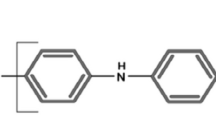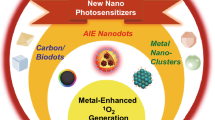Abstract
A silanization process was employed to transfer hydrophobic quantum dots (QDs) prepared via an organic route at high temperature into water phase. The QDs were further coated with a thin organic SiO2 shell to form QDs@SiO2 composite nanoparticles by ligand exchange or remaining initial organic ligands on the surface. In this study, QDs with different ligands, either trioctylphosphine oxide (TOPO) or oleic acid (OA), were employed to investigate the effects of ligands on the reverse micelles in preparing QDs@SiO2 nanoparticles. In the preparing process, hydrophobic QDs were silanized by partially hydrolyzed tetraethyl orthosilicate (TEOS). For TOPO-capped CdSe QDs, surface TOPO ligands were completely replaced by partially hydrolyzed TEOS. As for OA-capped CdSe/Cd x Zn1−x S QDs, surface OA ligands were partially replaced. It was found that the ligand exchange drastically reduced the photoluminescence (PL) efficiency of CdSe QDs. Furthermore, the cytotoxicity studies of QDs@SiO2 have been carried out in detail. The results indicate that CdSe/Cd x Zn1−x S QDs@SiO2 composite nanoparticles exhibit lower cytotoxicity compared with CdSe QDs@SiO2, because the SiO2 shell and remained OA ligand layer can effectively prevent the leakage of toxic Cd2+ ions. Meanwhile, it was found that these CdSe/Cd x Zn1−x S QDs@SiO2 nanocomposites could keep excellent PL properties even for 24 h incubating with Siha cells, which indicating that our prepared composite nanoparticles are potentially applicable for cell imaging in biological systems.







Similar content being viewed by others
Abbreviations
- QDs:
-
Quantum dots
- PL:
-
Photoluminescence
- W/O:
-
Water-in-oil
- TEOS:
-
Tetraethyl orthosilicate
- TOPO:
-
Trioctylphosphine oxide
- OA:
-
Oleic acid
- TOP:
-
Trioctylphosphine
- HDA:
-
Hexadecylamine
- TOP:
-
Trioctylphosphine
- ODE:
-
1-Octadecene
- FBS:
-
Fetal bovine serum
- MTT:
-
3-(4,5-Dimethylthiazol-2-yl)-2,5-diphenyltetrazolium Bromide
- DMSO:
-
Dimethyl sulfoxide
- TEM:
-
Transmission electron microscopy
References
Aldana J, Wang YA, Peng XG (2001) Photochemical instability of CdSe nanocrystals coated by hydrophilic thiols. J Am Chem Soc 123:8844–8850
An MY, Cui JB, He Q, Wang LY (2013) Down-up-conversion luminescence nanocomposites for dual-modal cell imaging. J Mater Chem B 1:1333–1339
Brucheer JM, Moronne M, Gin P, Weiss S, Alivisators AP (1998) Semiconductor nanocrystals as fluorescent biological labels. Science 281:2013–2015
Chan WC, Nie S (1998) Quantum dot bioconjugates for ultrasensitive nonisotopic detection. Science 281:2016–2018
Cho S, Jung SW, Jeong SH, Bang J, Park J, Park Y, Kim S (2013a) Strategy for synthesizing quantum dot-layered double hydroxide nanocomposites and their enhanced photoluminescence and photostability. Langmuir 29:441–447
Cho S, Kwag J, Jeong S, Baek Y, Kim S (2013b) Highly fluorescent and stable quantum dot-polymer-layered double hydroxide composites. Chem Mater 25:1071–1077
Deng D, Zhang WH, Chen XY, Liu F, Zhang J, Gu YQ, Hong JM (2009) Facile synthesis of high-quality, water-soluble, near-infrared-emitting PbS quantum dots. Eur J Inorg Chem 2009:3440–3446
Dorokhin D, Tomczsk N, Han MY, Reinhoudt DN, Velders AH, Vancso GJ (2009) Reversible phase transfer of (CdSe/ZnS) quantum dots between organic and aqueous solutions. ACS Nano 3:661–667
Gerion D, Pinaud F, Williams SC, Parak WJ, Zanchet D, Weiss S, Alivisatos AP (2001) Synthesis and properties of biocompatible water-soluble silica-coated CdSe/ZnS semiconductor quantum dots. J Phys Chem B 105:8861–8871
Koole R, Schooneveld MM, Hilhorst J, Donegá CM, Hart DC, Blaaderen AV, Vanmaekelbergh D, Meijerink A (2008) On the incorporation mechanism of hydrophobic quantum dots in silica spheres by a reverse microemulsion method. Chem Mater 20:2503–2512
Li T, Moon J, Morrone AA, Mecholsky JJ, Talham DR, Adair JH (1999) Preparation of Ag/SiO2 nanosize composites by a reverse micelle and sol-gel technique. Langmuir 15:4328–4334
Liu IS, Lo HH, Chien CT, Lin YY, Chen CW, Chen YF, Su WF, Liou SC (2008) Enhancing photoluminescence quenching and photoelectric properties of CdSe quantum dots with hole accepting ligands. J Mater Chem 18:675–682
Liu YF, Xie B, Yin ZG, Fang SM, Zhao JB (2010) Synthesis of highly stable CdTe/CdS quantum dots with biocompatibility. Eur J Inorg Chem 2010:1501–1506
Ma Q, Serrano IC, Palomares E (2011) Multiplexed color encoded silica nanospheres prepared by stepwise encapsulating quantum dot/SiO2 multilayers. Chem Commun 47:7071–7073
Ma YF, Li Y, Ma SJ, Zhong XH (2014) Highly bright water-soluble silica coated quantum dots with excellent stability. J Mater Chem B 2:5043–5051
Pellegrino T, Manna L, Kudera S, Liedl T, Koktysh D, Rogach AL, Keller S, Radler J, Natile G, Parak WJ (2004) Hydrophobic nanocrystals coated with an amphiphilic polymer shell: a general route to water soluble nanocrystals. Nano Lett 4:703–707
Saikia K, Deb P, Kalita E (2013) Facile synthesis of highly luminescent ZnSe(S) alloyed quantum dot for biomedical imaging. Curr Appl Phys 13:925–930
Santra S, Yang H, Dutta D, Stanley JT, Holloway PH, Tan WH, Moudgil BM, Mericle RA (2004) TAT conjugated, FITC doped silica nanoparticles for bioimaging applications. Chem Commun 2004:2810–2811
Sevinc E, Ertas FS, Ulusoy G, Ozen C, Acar HY (2012) Meso-2,3-dimercaptosuccinic acid: from heavy metal chelation to CdS quantum dots. J Mater Chem 22:5137–5144
Shen YY, Li LL, Lu Q, Ji J, Fei R, Zhang JR, Abdel-Halim ES, Zhu JJ (2012) Microwave-assisted synthesis of highly luminescent CdSeTe@ZnS–SiO2 quantum dots and their application in the detection of Cu(II). Chem Commun 48:2222–2224
Tang JH, Xie L, Zhang B, Qiu T, Qi B, Xie HP (2012) Preparation of strongly fluorescent silica nanoparticles of polyelectrolyte-protected cadmium telluride quantum dots and their application to cell toxicity and imaging. Anal Chim Acta 720:112–117
Wang F, Xie Z, Zhang H, Liu CY, Zhang YG (2011) Highly luminescent organosilane-functionalized carbon dots. Adv Funct Mater 21:1027–1031
Yang YH, Jing LH, Yu XL, Yan DD, Gao MY (2007) Coating aqueous quantum dots with silica via reverse microemulsion method: toward size-controllable and robust fluorescent nanoparticles. Chem Mater 19:4123–4128
Yang P, Murase N, Suzuki M, Hosokawa C, Kawasaki K, Kato T, Taguchi T (2010) Bright, non-blinking, and less-cytotoxic SiO2 beads with multiple CdSe/ZnS nanocrystals. Chem Commun 46:4595–4597
Yang P, Ando M, Murase N (2011) Highly luminescent CdSe/Cd x Zn1−x S quantum dots coated with thickness-controlled SiO2 shell through silanization. Langumir 27:9535–9540
Yang J, Ma Q, Yang P (2012) Tunable luminescence of spherical CdSe/ZnS and tetrahedron CdSe/Cd1−x Zn x S core/shell quantum dots created using same cores. Mater Chem Phys 135:486–492
Yi DK, Selvan ST, Lee SS, Papaefthymiou GC, Kundaliya D, Ying JY (2005) Silica-coated nanocomposites of magnetic nanoparticles and quantum dots. J Am Chem Soc 127:4990–4991
Acknowledgments
This work was partly supported by the program for Taishan Scholars, the projects from the National Natural Science Foundation of China (51572109, 51202090, 51302106, 51402123, and 51402124).
Author information
Authors and Affiliations
Corresponding author
Rights and permissions
About this article
Cite this article
Du, Y., Yang, P., Matras-Postolek, K. et al. Low toxic and highly luminescent CdSe/Cd x Zn1−x S quantum dots with thin organic SiO2 coating for application in cell imaging. J Nanopart Res 18, 37 (2016). https://doi.org/10.1007/s11051-016-3347-8
Received:
Accepted:
Published:
DOI: https://doi.org/10.1007/s11051-016-3347-8




